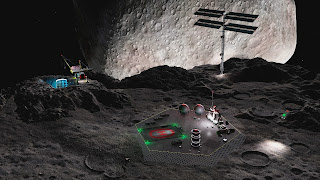MINING THE ASTEROID: A DREAM NOT FAR BEING REALIZED
MINING THE ASTEROID: A DREAM NOT FAR BEING REALIZED
Nikunja
Bihari Sahu
In a landmark
development on Sept 24, 2023, a sample
weighing nearly 250g collected by a spacecraft
of NASA named OSIREX REx from a small asteroid Bennu of our Asteroid Belt
was successfully delivered to our Earth for research
and study by the scientists. In a novel
exercise, the spacecraft did not land on the Earth, but rather released a
capsule from nearly 1,00,000 km altitude which entered the Earth's
atmosphere and parachuted with reduced velocity to
safely land with the sample in the Utah
desert. The spacecraft, without landing on the Earth, headed for another
asteroid in our Asteroid belt for further mission. Although
the sample collected was minuscule in quantity
and was only meant for scientific study, the mission aroused the hope of mining
precious metals like Gold and Platinum from the asteroids
and ferrying them safely to the Earth for the benefit of entire humanity.
An asteroid is a minor planet that orbits within our inner Solar System. These are rocky, metallic or icy bodies with no
atmosphere and very little gravity. Sizes and shapes of asteroids vary
significantly, ranging from 1-meter rocks to a dwarf planet almost 1000 km in diameter. Of the roughly 1
million known asteroids, the greatest number are located between the
orbits of Mars and Jupiter, approximately within 2 to 4 AU distance from the Sun, in the main Asteroid Belt. The size of asteroids varies greatly; the
largest asteroid Ceres is almost 1000 km across and qualifies as a Dwarf planet. The total mass of all the asteroids combined is only 3%
that of the Earth's Moon. The majority of main belt asteroids follow slightly
elliptical stable orbits revolving in the same direction as the Earth and
taking from 3 to 6 years to complete a full circuit of the Sun. The asteroid 4- Vesta, due to its high reflective surface, is
normally visible to the naked eye from the Earth.
There are mainly three types of asteroids, namely C-type, S-type and M-type:
C-type or Carbonaceous asteroids are the most common variety, forming around 75% of known asteroids. They are volatile-rich and distinguished by a very low albedo because their composition includes a large amount of carbon, in addition to rocks and minerals. They have an average density of about 1.7 g/cm3. The C-type asteroids have a high abundance of water. C-type asteroids also have high amounts of organic carbon, phosphorus, and other key ingredients for fertilizer which could be used to grow plants in a space environment.
The S-type or Silicate asteroids are mostly stony and made out of Iron silicates or Magnesium silicates. S-type asteroids carry little water but are more attractive because they contain numerous metals including Nickel, Cobalt, and more valuable metals, such as Gold, Platinum, and Rhodium. A small 10m size S-type asteroid could contain as much as 650,000 kg of metal with 50 kg in the form of rare metals like Platinum and Gold.
A class of easily retrievable objects (EROs) was identified by a group of researchers in 2013. Twelve asteroids made up the initially identified group, all of which could be potentially mined with present-day rocket technology. Of the 9,000 asteroids searched in the Near Earth Objects (NEO) database, these twelve could all be brought into an Earth-accessible orbit by changing their velocities by less than 500 meters per second (1,800 km/h; 1,100 mph). The dozen asteroids range in size from 2 to 20 meters.
Composition of
Asteroids and Why These are of Interest to Us
Although asteroids and Earth accreted from
the same starting materials, Earth's relatively stronger gravity pulled all
heavy siderophilic (Iron-loving) elements into its
core during its molten youth stage more than 4 billion years ago. This
left the crust depleted of such valuable elements until a rain of asteroid
impacts re-infused the depleted crust with gold, cobalt, iron, manganese, molybdenum, nickel, osmium, palladium, platinum, rhenium, rhodium, ruthenium and tungsten among other metals. Today, these metals are
generally mined from Earth's crust and form an
essential stuff
for our economic and technological progress. From one point of
view, it is believed that mining the asteroids would
be relatively easy because, unlike our Earth, most
valuable deposits are located near the asteroid’s
surface rather than near the core . But the only
obstacle is to reach there!
Even without a
manned mission to do a full-scale study of an asteroid, scientists know a lot
about what these bodies contain from Earth-based
measurements. Astronomers use telescopic spectroscopy which analyzes light
reflected from the asteroid's surface, to find out their composition. In
addition to metals like Iron, Nickel and Magnesium,
scientists think Water, Oxygen, Gold and Platinum also exist on some asteroids. Water interests space
explorers most, because it could help keep a space colony alive as without
water, there is really no way to move ahead
with human exploration of space. Water could also be broken down by the method
of electrolysis using sunlight into its constituent elements such as Hydrogen and Oxygen to form rocket
engine propellant. The metals mined and extracted from the asteroids could also be used
for building spacecraft and other structures for a space colony that would
further ease asteroid exploration.
The drive to set up a sustained mining operation in place on an asteroid is , by no means, an easy task. While building an asteroid mine will cost billions of dollars, it will be far cheaper than carrying supplies from Earth to the Moon or Mars. Spacecraft would have to carry food and supplies for the mining crew and the equipment for mining activities. Newly developed spacecraft should make landing on an asteroid possible. After all, man has already landed on the Moon and some asteroids pass-by closer than the Moon from the Earth. A spacecraft going to an asteroid would need less rocket power and fuel than one going to the Moon. One problem will be how to keep the asteroid from rotating while it is being mined. Some experts suggest attaching rockets to the asteroid to take the spin out of it. But once miners land on the asteroid, they have to plan to dig it for minerals, process the materials extracted and transport it to a space colony orbiting around the Earth or directly to the Earth itself. Although no one knows for sure what the first asteroid mine will look like, there are some good assumptions about them which are outlined below:
Asteroid
mining activities would involve drilling boreholes and injecting hot liquid or gas and allowing the
useful materials to react or melt with the solvent and extract the solute. Due
to the weak gravitational fields of asteroids, any activities, like drilling or boring, will cause large surface
disturbances to eject plumes of dust clouds.
These might be confined by some dome or bubble barrier, or else some means of rapidly dust dissipating
mechanism should be provided for to get
rid of these dusts. Mining operations require special equipment to handle the
extraction and processing of ore in outer space. The machinery will need
to be anchored to the body of the asteroid; but
once in place, the ore can be moved about more readily due to the lack of
gravity. However, no technique for refining ore in zero gravity conditions
currently exists. Docking with an asteroid
might be performed using a harpoon-like process, where a projectile would
penetrate the surface to serve as an anchor; then an attached cable would be
used to winch the vehicle to the surface if the asteroid is both penetrable and
rigid enough for a harpoon to be effective.
The machinery will likely to be solar-powered to reduce the need for fuel that would have to be hauled
to the asteroid by a spacecraft. All the equipment should be light-weight for easy transport to the asteroid. Most equipment will be robotic in nature
to reduce the need for manpower to
carry out mining activities. This would bring down the amount of
supplies, like food and other essential items required for a long manned
mission. Miners on asteroids would use techniques similar to those on the Earth. The
most likely method will be to scrape
desired materials off the asteroid and tunnel into veins of specific
substances. Scraping or Strip mining will pull out valuable ore that will float
off the asteroid. Because much of the ore will fly off, a large canopy might be
used to collect it. As the asteroids have little
gravity, the mining equipment, and the astronaut
miners who operate them, will have to use grapples to
anchor themselves securely to the ground. However, the lack of gravity is an
advantage in moving mined materials around without having to use much muscle
power. Once a load of materials is ready to be sent to the Earth or to a space colony around it, rocket fuel for a
ferrying spacecraft could be produced by breaking down water harvested from the
asteroid into Hydrogen and Oxygen molecules. After an asteroid's minerals and resources have been completely
exhausted by the mining project, the mining equipment can be shifted to another potential asteroid candidate
for further mining without bringing them back to the Earth.
Economy of Mining
Currently, the
quality of the ore and the consequent cost and mass of equipment
required to extract it are unknown and can only be speculated. Some economic
analyses indicate that the cost of returning asteroid minerals to the Earth far outweighs their market value and that
asteroid mining will not attract private investment at current commodity prices
and space transportation costs. Other studies suggest that large profit
could be made by using solar power.
In 1997, it was
speculated that a relatively small metallic asteroid with a diameter of
1.6 km (1 mile) contains more than US$20 trillion worth of industrial
and precious metals. A comparatively small M-type asteroid with a mean diameter of 1 km (0.62 mle) could contain more than two billion metric tons of Iron–Nickel ore, or 2 to 3 times the world production of
2004. The asteroid 16-Psyche is believed to contain 1.7×1019 kg of
Nickel–Iron,
which could supply the world production requirement for several million years. In
fact, a small portion of an asteroid's extracted material would bea precious stuff in comparison to our Earth’s standards!
Not all mined
materials from asteroids would be cost-effective, especially for the potential
return of economic amounts of material to the Earth. For a potential return to Earth, Platinum is considered very rare in terrestrial geologic
formations and , therefore, is potentially worth bringing some quantity for
terrestrial use. Nickel, on the other hand, is quite abundant on Earth and is mined
in many terrestrial locations; hence, the high cost of asteroid mining may not make it
economically viable. The development of an
infrastructure for altering an asteroid’s
orbit to our technically favourable
locations could make our mining activities easier and would offer a large return on
investment.
Hence, if our
dream of mining the asteroids comes true, our planet Earth would be richer by
many counts by plundering the asteroid wealth!
Education Officer
Regional Science Centre
Bhopal
Phone : 8917637974




Comments
Post a Comment